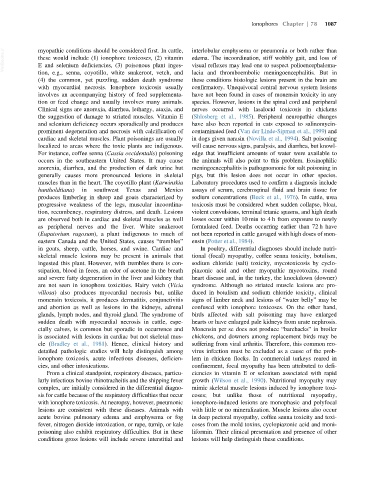Page 1155 - Veterinary Toxicology, Basic and Clinical Principles, 3rd Edition
P. 1155
Ionophores Chapter | 78 1087
VetBooks.ir myopathic conditions should be considered first. In cattle, interlobular emphysema or pneumonia or both rather than
edema. The incoordination, stiff wobbly gait, and loss of
these would include (1) ionophore toxicoses, (2) vitamin
visual reflexes may lead one to suspect polioencephaloma-
E and selenium deficiencies, (3) poisonous plant inges-
tion, e.g., senna, coyotillo, white snakeroot, vetch, and lacia and thromboembolic meningoencephalitis. But in
(4) the common, yet puzzling, sudden death syndrome these conditions histologic lesions present in the brain are
with myocardial necrosis. Ionophore toxicosis usually confirmatory. Unequivocal central nervous system lesions
involves an accompanying history of feed supplementa- have not been found in cases of monensin toxicity in any
tion or feed change and usually involves many animals. species. However, lesions in the spinal cord and peripheral
Clinical signs are anorexia, diarrhea, lethargy, ataxia, and nerves occurred with lasalocid toxicosis in chickens
the suggestion of damage to striated muscles. Vitamin E (Shlosberg et al., 1985). Peripheral neuropathic changes
and selenium deficiency occurs sporadically and produces have also been reported in cats exposed to salinomycin-
prominent degeneration and necrosis with calcification of contaminated feed (Van der Linde-Sipman et al., 1999)and
cardiac and skeletal muscles. Plant poisonings are usually in dogs given narasin (Novilla et al., 1994). Salt poisoning
localized to areas where the toxic plants are indigenous. will cause nervous signs, paralysis, and diarrhea, but knowl-
For instance, coffee senna (Cassia occidentalis) poisoning edge that insufficient amounts of water were available to
occurs in the southeastern United States. It may cause the animals will also point to this problem. Eosinophilic
anorexia, diarrhea, and the production of dark urine but meningoencephalitis is pathognomonic for salt poisoning in
generally causes more pronounced lesions in skeletal pigs, but this lesion does not occur in other species.
muscles than in the heart. The coyotillo plant (Karwinskia Laboratory procedures used to confirm a diagnosis include
huntholdtiana) in southwest Texas and Mexico assays of serum, cerebrospinal fluid and brain tissue for
produces limberleg in sheep and goats characterized by sodium concentrations (Buck et al., 1976). In cattle, urea
progressive weakness of the legs, muscular incoordina- toxicosis must be considered when sudden collapse, bloat,
tion, recumbency, respiratory distress, and death. Lesions violent convulsions, terminal tetanic spasms, and high death
are observed both in cardiac and skeletal muscles as well losses occur within 10 min to 4 h from exposure to newly
as peripheral nerves and the liver. White snakeroot formulated feed. Deaths occurring earlier than 72 h have
(Eupatorium rugosum), a plant indigenous to much of not been reported in cattle gavaged with high doses of mon-
eastern Canada and the United States, causes “trembles” ensin (Potter et al., 1984).
in goats, sheep, cattle, horses, and swine. Cardiac and In poultry, differential diagnoses should include nutri-
skeletal muscle lesions may be present in animals that tional (focal) myopathy, coffee senna toxicity, botulism,
ingested this plant. However, with trembles there is con- sodium chloride (salt) toxicity, mycotoxicosis by cyclo-
stipation, blood in feces, an odor of acetone in the breath piazonic acid and other myopathic mycotoxins, round
and severe fatty degeneration in the liver and kidney that heart disease and, in the turkey, the knockdown (downer)
are not seen in ionophore toxicities. Hairy vetch (Vicia syndrome. Although no striated muscle lesions are pro-
villosa) also produces myocardial necrosis but, unlike duced in botulism and sodium chloride toxicity, clinical
monensin toxicosis, it produces dermatitis, conjunctivitis signs of limber neck and lesions of “water belly” may be
and abortion as well as lesions in the kidneys, adrenal confused with ionophore toxicoses. On the other hand,
glands, lymph nodes, and thyroid gland. The syndrome of birds affected with salt poisoning may have enlarged
sudden death with myocardial necrosis in cattle, espe- hearts or have enlarged pale kidneys from urate nephrosis.
cially calves, is common but sporadic in occurrence and Monensin per se does not produce “barebacks” in broiler
is associated with lesions in cardiac but not skeletal mus- chickens, and downers among replacement birds may be
cle (Bradley et al., 1981). Hence, clinical history and suffering from viral arthritis. Therefore, this common reo-
detailed pathologic studies will help distinguish among virus infection must be excluded as a cause of the prob-
ionophore toxicosis, acute infectious diseases, deficien- lem in chicken flocks. In commercial turkeys reared in
cies, and other intoxications. confinement, focal myopathy has been attributed to defi-
From a clinical standpoint, respiratory diseases, particu- ciencies in vitamin E or selenium associated with rapid
larly infectious bovine rhinotracheitis and the shipping fever growth (Wilson et al., 1990). Nutritional myopathy may
complex, are initially considered in the differential diagno- mimic skeletal muscle lesions induced by ionophore toxi-
sis for cattle because of the respiratory difficulties that occur coses; but unlike those of nutritional myopathy,
with ionophore toxicosis. At necropsy, however, pneumonic ionophore-induced lesions are monophasic and polyfocal
lesions are consistent with these diseases. Animals with with little or no mineralization. Muscle lesions also occur
acute bovine pulmonary edema and emphysema or fog in deep pectoral myopathy, coffee senna toxicity and toxi-
fever, nitrogen dioxide intoxication, or rape, turnip, or kale coses from the mold toxins, cyclopiazonic acid and moni-
poisoning also exhibit respiratory difficulties. But in these liformin. Their clinical presentation and presence of other
conditions gross lesions will include severe interstitial and lesions will help distinguish these conditions.

